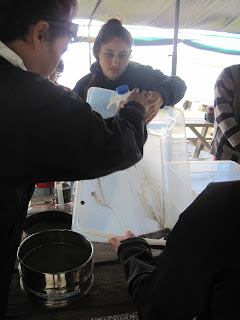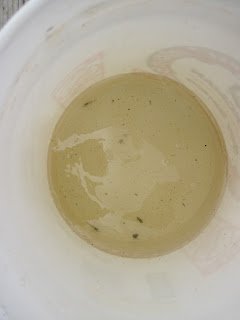It was another beautiful windy day at the Paepae O Heʻeia. Today's ʻole moon's turbulant winds and currents pushed an unpleasant surprise into the break wall. A honu that uncle said looks like got hit by a motor boat. Good thing Judy knew the proper protocol and notified NOAA at once. RIP Honu.
Kinaʻu and I had the dandy job of trekking all around in the pond. Thankfully today's shallow tides allowed us to go into the middle of the pond with out the water coming above our knees.
It took a couple tries but Kinaʻu pulled out a fine core sample.
Before we even started our trek back to the kuapā the sample settled distinguishing the layers of our core sample.Our first task with our core sample was to make scientific observations that makes jordan smile bright:] We use mm not inches when measuring. We took note of the granual size change and color changes. We also discovered Tiffs artistic talents as she drew beautiful replicas of the samples in her notebook.
Kinaʻu's sampel from the middle of the pond was full of life with 6+ opae and a brittle star. Our LAIP group was split into three groups to obtain samples from three different sites around and inside the pond. 1) At the end of the restored Kuapā 2)outside in Kāneohe Bay 3)in the middle of the pond.
After our observations were complete we emptied our samples into colanders
After the colander was fully cleaned using distilled water we collected the remnants into test tubes to be looked at closer in the lab.Every last bit of the core sample was bottled into containers to be taken for further observations in the lab.
And so concluded another sciencey day at Paepae o Heʻeia. Mahalo.

































